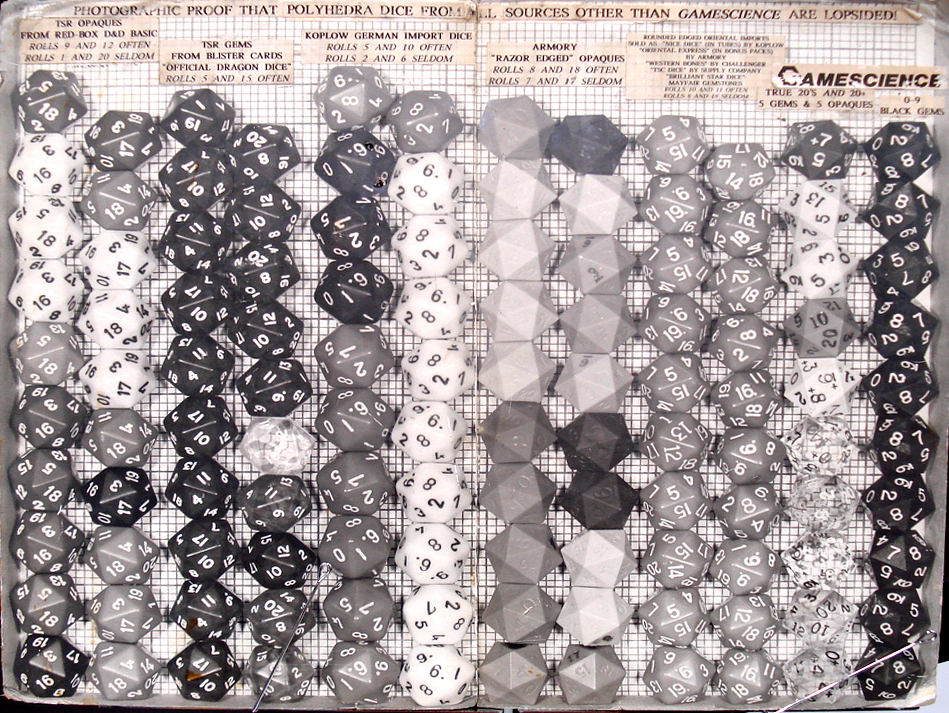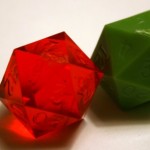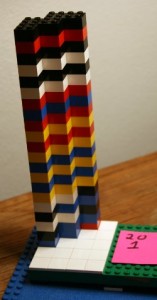So the player characters are tromping through a giant mushroom forest this week… what do I say to them? I need to tell them about the forest, but what words should come out of my mouth? Stopping with, “You walk into a giant mushroom forest,” won’t convey the world I’ve built in my head at all.
Narration advice I’ve heard includes: “read more”, “play lots of games and emulate your favorite GMs”, and simply “practice.” These are great suggestions but they don’t work for everyone. The anxiety jitters I feel when I sit down to GM haven’t gone away despite doing all those things.
After a lot of struggling, I found more specific narration suggestions in the writing community. Much of this post is based on the content and structure of a post by N. Strauss. Similar ideas and variations of them are discussed, in different terms, in this article by Stephen King from 1980 (link may be unreliable). I also found useful tips on scene goals in this post by Chris Eboch. I condensed and reframed their ideas to more directly apply to tabletop RPG narration.
Many of these techniques are for describing physical places or people and most generalize to describing anything else that’s physically perceptible: creatures, spell effects, plants, prophetic visions, etc. Don’t feel limited by the exact examples I picked.
Before a game I sit down and write short bullet lists of three to eight items for places and NPCs the players are likely to run into. When I narrate I incorporate the points from the lists. I sometimes create more than I need, but no single place or person takes long. The things that I prepare ahead of time are much more vivid than things I come up with at the table.
Use specific details in your descriptions.
Imagine I’m GMing and I say, “Your party reaches a small village”, what are you picturing? Form an image of the scene in your mind.
Suppose I said, “Your party reaches a small gnomish village. All the homes and shops are diminutive but sturdy and well built.” Is the picture in your mind’s eye a bit different now?
How about, “Your party reaches a small gnomish village just as the sun begins sinking beneath the horizon. The diminutive homes and shops are sturdy and well built but strangely quiet. Doors are closed, windows are shuttered, and you don’t see anyone in the streets.” Is this place giving you a slightly different impression? Would your plan for what to do next change based on these details?
Specific details help the players take in the world the way they would if they were really there. Details also help players figure out how to begin reacting to the world and investigating new places and people.
Choose the details carefully.
It’s easy to fall into the trap of thinking more details is more better, but a flood of irrelevant details will blot out the bigger picture and bore the monkeys out of your players. At some point they’ll tune out your “boxed text” or, worse yet, become actively disruptive in an attempt to make you stop talking.
Pick details that make the picture clear without overwhelming the players. If you’re worried about camouflaging something in the scene, like a trap trigger or hidden loot, make the environment more complex and interesting instead of padding the description with irrelevant details.
A competent trap builder would know better than to put an obvious pit trap in an otherwise featureless 10 by 10 room. Likewise, players don’t need to hear about the size and shape of every barrel in a storeroom if none of them are relevant to their quest or contain anything interesting.
Choose details that differentiate.
Just about every fantasy character has a race, so if you tell me a woman is an elf that doesn’t help me to picture her or know how to react to her. If you tell me she’s a thin elf in traveling clothing carrying a bow, I have more of an idea of who she is. There are still a lot of elves that could describe. If you also tell me she has a scar across her left eye, a medallion of the local neutral elven god around her neck, and an air of disdain about her when she looks at the non-elven party members, I have a much clearer impression. These details distinguish her from other elves the PCs will meet in their travels.
When you have to describe something, ask yourself how is this _____ different from all the other _____s that my party will run into?
Use details that suggest a bigger picture.
If you describe a tavern table as unpleasantly sticky, with a visible layer of grime that hasn’t been cleaned in years, I’m likely to assume the rest of the building is in a similarly disgusting and flea infested state. If you tell me that a cavern is scattered with fresh bones I’m likely to assume that a dangerous predator lives here… and could be coming back soon!
Keep the situation beyond the immediate scene in mind when you describe the surroundings. Include details that foreshadow or offer clues about things you want the players to know or guess.
This holds for characters and monsters as well. Scars, clothing, colors, patterns, and adornments can suggest their history and allegiances or foreshadow their future plans and loyalties.
Describe things the way the characters would perceive them.
Different player characters are likely to notice different things in the same situation. You can add a lot of flavor by giving a player additional description specific to their character’s history, unique skills, or physical position in the environment.
For example, a rogue may have a sharper eye on the details of security, like locks and guard patterns, or they may notice how easily NPCs could be bamboozled or pickpocketed. Someone who grew up locally might be quicker to pick out strange changes to local traditions. A shorter race like a halfling (or someone who’s been knocked to the floor with a well timed punch) will probably have an easier time seeing a paper pinned to the underside of a table.
Don’t force the PC to mechanically test for this information. This isn’t hard for them to notice; you’re telling them about things they can see easily that others would have a more difficult time perceiving.
You can pass PC-specific description to a player in a note or verbally. If you start passing notes it’s up to the player if they want to share the information truthfully with the others. If you tell them verbally the other players will know, whether or not their characters find out. Each strategy has it’s strengths and some groups handle one or the other with more grace.
Incorporate all the senses in the description.
Picture a scene in your mind and imagine the visuals of what the characters would see there. If you also think about how it smells, what temperature it is, and what it sounds like it’ll feel more like a real place. Sounds, smells, and other tactile cues don’t need to be ominous or strange. A bakery might smell of cinnamon, or closing a door might dampen the noise from a party the characters are sneaking out of. The existence of the other senses will better connect your players to the moment and can give them hints to what’s happening around them.
This particular piece of advice is a bit trite, but used with the other techniques, it creates more immersive and vivid descriptions.
Tell players what they perceive, not how they feel about it.
When you GM it feels easy to describe things in terms of reactions or judgments. I can’t count the number of times GMs have told me non-player characters were “sweet” or “trustworthy” when my first reaction was they’ll more likely than not push me into a volcano if I turn my back on them. As a GM you don’t get to dictate how PCs feel about the world. Nine times out of ten if you try to tell them how to feel they’ll ignore you anyway.
Pushing value judgments also isn’t an effective way to describe things. “You see at a scary castle,” isn’t going to make your players feel fear. Instead choose specific details that are intended to make the castle sound ominous and uninviting.
“After hours of trudging up and down you round the curve of a last hill and get your first glimpse of the castle. It’s still about a half mile away, up the twisting, winding path on the mountainside. The castle’s foundation juts out from the rocks of the cliffside so that half of it sits over empty air. In the shadow of the mountain it’s hard to make out the exact shape of the castle walls, but you can pick out the dark roofs of the jagged tower tops silhouetted against the sky. The wind picks up and you can hear a faint whistling or howling from somewhere within the castle’s crumbling stones.”
If you describe a scary castle, the players will feel the fear on their own.
Phrase descriptions in terms of what the PCs perceive. Avoid describing things with value judgments (“nice”, “ugly”, “beautiful”, “kindly”) or feelings that imply a character’s reaction (“scary”, “infuriating”, “lovable”, “confusing”). To get a specific reaction or value judgment from the PCs, focus on describing details that would cause you to react that way or make that value judgement.
Note: There are some times when mechanics like magic dictate how a character feels. Those are an obvious exception here. It’s still important to give the players some agency. Yes, the mechanics may say their character must flee from the dragon in terror, but while terrorized and fleeing different characters are going to react differently. Tell the player the restrictions of the mechanic and let them narrate their own (re)actions under those restrictions.
Describe things with a purpose.
Narration is a powerful tool. It can help you to move the plot forward, create moods, give players big pieces of information, or subtle hints and nudges in new direction when they get confused. You can pack a lot into each scene.
In a tabletop game you don’t always know where the protagonists are headed. Sometimes the players expect a scene to be important, and it doesn’t match where you thought the plot was going, so you don’t have anything planned. You can still strive to make the most of whatever situation the party wanders off into.
You can use a scene to:
- advance the current plot
- advance the over-arching plot
- give the characters important information
- give the characters hints or rumors about the over-arching plot
- reveal something about the PCs or NPCs
- reveal something about the world
- develop a theme or foreshadow a future event
- set the mood
When you imagine a scene for the first time, pick one to four of these goals you want to accomplish in the scene. You’ll need to decide the specifics of the goals, like what future event you’d be foreshadowing. When you come up with your descriptions be sure to include at least one or two details that support each of the goals you chose and, if possible, a few details related to what the players are likely to want from the area.
Revealing things about the protagonists in tabletop games is slightly different than in books. It can be prompted by something the GM pulled from a character’s backstory and worked into the current plot. It can also be spontaneous and player driven. When I run long term games I compile lists of themes and elements players have built into their characters. Using these same themes and elements in the plot or incidentally in the world can give the players opportunities to build on their characters, without pulling the development out of their hands.
Setting the mood in a scene is crucial in some genres and it’s different with a table full of players than a single reader. I try to slowly build up to mood changes over several scenes in the way that a good horror story builds up normality. For horror and unease specific mood, I’ve found that weather, light, and heat related descriptions can have a profound impact on how players feel about about a place. Often how uneasy my players are is directly proportional to how normal vs unnatural the weather and temperature is. For example, if the party enters a shop, it can also be dark, strangely cold and damp, or smelling of mouldy books.
Summary
Put your descriptions in terms of what the PCs perceive. Include specific details and pick enough of them to illustrate important things in the scene without going into all the irrelevant minutiae. Decide which details to use by asking how the specific thing you’re describing differs from similar ones the PCs have seen or will run into. Use descriptions including multiple types of sensory information (sight, sound, smell, touch, etc.). When possible offer individual PCs different details geared toward their personal view of the world. If you want the players to feel something or make a value judgment, focus on describing details that would cause you to feel those feelings or make that value judgement.
Decide if there are situations or future events beyond the immediate scene you want to foreshadow. Pick one to four specific goals you’d like to accomplish in each scene.
Don’t worry if you only use some of these tips at any given time. A scene in a tabletop game doesn’t need to be a perfectly nuanced and polished masterpiece. The purpose of descriptions in RPGs is to convey the important details to the players, not write a book.
What about all that other narration that’s not description?
There’s a lot to narration that’s not description of the static physical state of things. Action narration, combat narration, and effectively role-playing NPCs are each their own cans of worms that I’m not going to open right now. Depending on my motivation I may write about more of these in the future. 🙂





